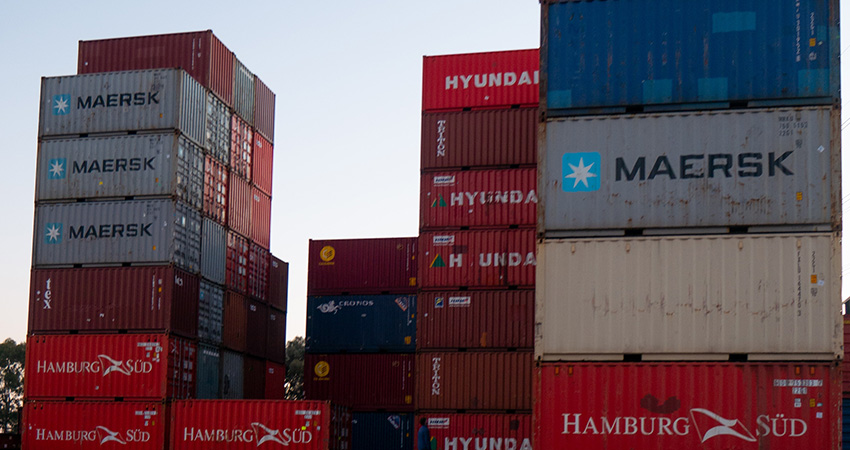The first mile of your supply chain, in from the port, is just as critical as the last mile (credit: Pat Whelen on Unsplash)
With all the focus on winning in the last mile, companies need to pay more attention to the criticality of first mile success, addressing the various headwinds that beset it.
Just as businesses started bouncing back from the pandemic impact, a new wave of unpredictability has hit. Economic uncertainty, escalating costs and worldwide conflicts are stripping the veneer off the supply chain, revealing its frailties.
Among these, the susceptibility of the first mile stands out. The stage where products are sourced, manufactured and shipped from point of origin is feeling the brunt of market volatility. Potentially costly strikes averted at UPS plus U.S. West Coast ports – and actual stoppages in Canada, since settled – were not just headline-grabbing events. They exposed just how fine a line there is between supply chain triumph and turmoil. They also serve as an urgent wake-up call for businesses to confront the intricate challenges of the first mile.
Brands need to strike a balance in optimizing their supply chain’s first mile that maintains the triumvirate of efficiency, affordability and overall performance. Let’s unpack two critical areas within the first mile that brands must focus on to mitigate risks and assure a seamless flow of goods.
Strategically Balancing Delivery Speed and Margins
In international trade, transportation selection directly impacts both delivery time and cost. This pivotal decision has prompted businesses to reassess their freight strategies, seeking to maintain the delicate balance between expediency and profitability as disruptions occur. Considerations such as filling containers, costs and efficient shipping management are essential factors in this intricate process.
Businesses engaged in global trade have two primary options for freight transportation: ocean and air. According to our own recent research, 45% of businesses favor ocean freight as their primary importing method, while 38% opt for air freight. Each has its advantages and disadvantages, presenting unique trade-offs that shape decision-making.
Air freight offers unparalleled speed and efficiency, slashing lead times by up to 50% compared to ocean shipping. With fixed airline schedules, it provides a higher level of predictability. However, its advantages come at a cost, directly impact profit margins. This requires businesses to carefully weigh the benefits of accelerated delivery against financial considerations.
On the other hand, ocean freight offers a cost-effective solution for bulk shipments and large volumes. By leveraging economies of scale, businesses can reduce transportation expenses significantly. Nonetheless, longer transit times and potential disruptions stemming from weather conditions or port congestion introduce challenges, particularly for time-sensitive inventory and cash flow management.
There is another avenue businesses can explore to achieve an optimal balance: splitting shipments and adopting multi-modal transportation. By diversifying their shipping methods, companies can switch between transportation modes for some or all of an order while maintaining centralized management. This strategic approach allows for a tailored, agile shipping process that optimizes both delivery time and cost, accommodating the specific requirements of each shipment while carefully watching profit margins.
Optimizing Inventory Management in Uncertain Times
Effective inventory management is always important, but especially so during uncertain times. Excess inventory poses significant threats, tying up valuable working capital in unsold capital, when it could be invested elsewhere. It also results in higher warehousing and storage expenses, especially if additional space is required. It can also lead to obsolescence and depreciation, particularly in sectors with rapidly changing trends and technological advancements.
Alarmingly, two-thirds of businesses report being overstocked at present, our study found, yet 63% plan to increase inventory over the next 12 months. This highlights the urgent need for accurate forecasting and robust inventory management systems. Here’s what you can achieve by optimizing inventory management:
Elevate your visibility for optimal inventory control: Many online retailers prioritize scaling their brand through marketing, advertising and new product releases. They often neglect the significance of supply chain visibility, which is the key to mastering inventory management. By having a clear view of inventory and supply chain data, businesses can make informed decisions to optimize inventory control.
Contrary to popular belief, mastering inventory management isn’t solely reliant on AI and cutting-edge technology. Instead, it boils down to a single concept: visibility.
Preprocess your data for better forecasting: Forecast accuracy is crucial for effective stock management. Many ecommerce brands struggle with stockouts and overstocks due to flawed forecasting methods. Relying solely on moving averages or past sales data can lead to costly mistakes in inventory planning. To achieve accurate forecasts, it is essential to start with accurate data.
Find success with inventory as you scale: As businesses expand into new channels, inventory complexities increase. While sophisticated algorithms and calculations play a role, visibility makes the real difference. Businesses must be able to answer critical questions about their inventory. How many units are sitting in distribution and fulfillment centers or open purchase orders? How many can be rerouted or delayed if needed? How many are already in transit to storage, and how many are in production?
Investing in a robust supply chain management system, scaling data analytics, and leveraging demand forecasting are essential for answering these questions and gaining visibility. With a strong forecast and clearer insights across the supply chain, businesses can pinpoint profitable opportunities for new products, markets and supplier agreements. This leads to increased profits and cash flow as they scale.
Looking Ahead
In the midst of economic uncertainty, managing inventory and supply chain risks shifts are more critical than ever. Businesses must navigate the global supply chain’s intricacies with tactical decisions right from the first mile. The choice of transportation and the implementation of smart inventory management strategies become keys to mitigating risks and ensuring an uninterrupted stream of goods.
By increasing visibility, fine-tuning data for sharper forecasting and mastering inventory management as they expand, you can secure your footing even amidst turbulence. The first mile is more than a beginning; it lays the groundwork for a resilient, adaptable supply chain. It equips businesses to not just survive but flourish in a dynamic economic environment.
Rodney Manzo is Founder and CEO of Anvyl

